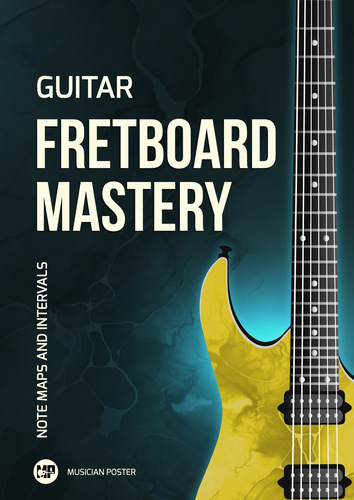Map of all notes on the fretboard for a 6-string guitar in Open-E tuning. Whether you're a beginner learning the notes or an experienced player exploring new tunings, this map will prove to be an invaluable resource.
How You Can Use This Chart
Here's a list of scenarios where you may find map like this to be really helpful.
- Visualize and memorize notes on the fretboard.
- Find different chord voicings, inversions or shapes.
- Understand scales in different positions across the fretboard.
- Explore new scales and modes.
- Find convenient patterns to play common arpeggios.
- Experiment with colorful modal arpeggios.
- Experiment with different instrument tunings.
But you are free and encouraged to come up with other uses as well and share them in the comment section below, I'd be happy to read your ideas. That way you are also sharing your experience with the rest of the community.
Features and Benefits of the Chart
- Any scale and chord: This single diagram allows you to play any scale, any chord from any string and with any root note, provided that you have the notes of the scale or chord in question.
- 12 and 24 frets: The charts are available in two variations: as 12 frets and as 24 frets.
- Color coding: Naturals and accidentals are color-coded differently to create a clear visual separation between them.
- Flats and sharps: Choose between "naturals + flats" and "naturals + sharps"—both flavors are included as separate charts.
- Doubled frets: Fret numbers are provided both below and above the diagram, offering additional visual cues to pinpoint your location and navigate the fretboard with even greater ease.
- Tuning in SPN: Tuning is provided in Scientific Pitch Notation so you get to see the octaves of each pitch without the need to look up a different reference. If you're unsure what they mean or what they are for you can just ignore them.
- Tuning Difference: As you explore alternative tunings, you will soon discover that you want to know how much they differ from the standard/factory tuning based on the number of strings your instrument has. This chart shows this difference in half-steps for each string, where negative numbers indicate that you need to tune lower than the given standard tuning, and positive numbers indicate that you need to tune higher. If you're not yet interested in this information you can just ignore it.
Alternative tuning spellings
For those who search for this content based on the tuning names, here are alternative spellings to increase the chances:
- EBEG#BE
- E-B-E-G#-B-E
- E2-B2-E3-G#3-B3-E4
















0 Comments